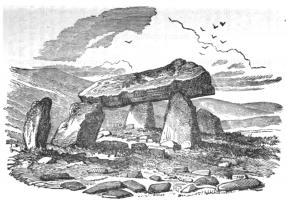Text this colour links to Pages. Text this colour links to Family Trees. Place the mouse over images to see a larger image. Click on paintings to see the painter's Biography Page. Mouse over links for a preview. Move the mouse off the painting or link to close the popup.
Gaer Llwyd Burial Chamber is in Gaerllwyd, Monmouthshire, Prehistoric Wales Neolithic Burials.

Book of South Wales. Between four and miles to the north of Caerwent on a hill forming part of a small farm, called Gaer Llwyd, about a mile from Newchurch-in which parish it is situated-is the Cromlech [Gaer Llwyd Burial Chamber [Map]], depicted in the accompanying sketch. The upper stone is twelve feet long and about three feet and a half broad, and the uprights vary from four to five feet. Vestiges of a trench and bank are discoverable round this Cromlech, which is the only one in the county, and has been strangely overlooked by Coxe and other topographers.